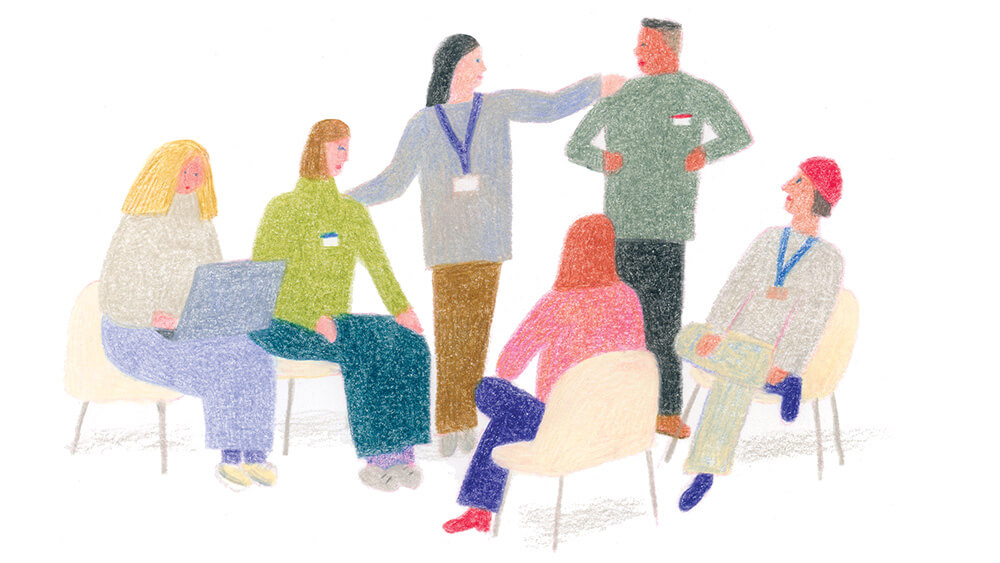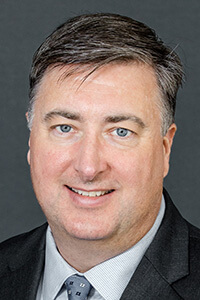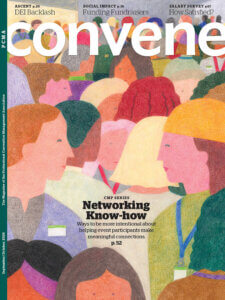
“When you’re gathering with 2,000-plus people, you want help to guide you,” said Barbara DiRocco, the National Association of College and University Business Officers’ (NACUBO) senior director of meetings and events. (Illustration by Line Hachem)
“What we used to call networking was actually socializing,” Barbara DiRocco, the National Association of College and University Business Officers’ (NACUBO) senior director of meetings and events said about the association’s Annual Meeting. “And what happens at a break or a reception is people just tend to socialize with the people they came with or people that they already know,” she told Convene during a recent video call, where she was joined by Randy Roberson, NACUBO’s vice president of leadership development. “That’s not networking.”
For the last five or six years, Roberson said, NACUBO has taken a more intentional approach, understanding that attendees want to connect with others for different reasons. “We’ve been bringing people together around” things they have in common, he said, “whether it be women leaders or leaders of color or LGBTQ leaders or young professionals, or if they were leaders from small institutions vs. large public research institutions vs. community colleges. We’ve always tried to focus on how we get those folks together to learn from one another and also feel like they have a camaraderie and a peer group they can talk to.”

Barbara DiRocco
DiRocco said that members want networking to be both organic and also a bit structured. “When you’re gathering with 2,000-plus people,” she said, it can feel like “you’re trying to wade through a sea of everybody trying to find your peer colleagues. You want help to guide you.”
Here are some ways NACUBO has done that.
Navigating NACUBO First-Time Attendee Session is held right before the opening event on Saturday evening. “There are 250-ish folks who attend that who now have people to go to that opening event with, to stand in a buffet line or to sit at a table with,” Roberson said, rather than going to the opening reception on their own.
“We do some little networking activities where we have them talk to each other. We show them how our polling system works and how our continuing ed credit system works. We also tell them about things that they may not know about,” Roberson said, like where to get in line for a book signing and go for your free headshot. “We’re in the financial space, and we have a lot of introverts join us. How do we make them feel comfortable as best we can, knowing that this is out of their comfort zone for many of them?” First-timer sessions also give attendees an opportunity to buddy up with another conference newbie to experience the rest of the event together.
Roundtables start on Sunday morning, organized around institution type — “Are you a small institution, a research university, a community college?” Roberson said. The roundtables are scheduled right before the main opening general session so that participants can walk in together to the large ballroom or auditorium. “Once again,” he said, “we’re trying to make it be not so overwhelming for them.”
Four Connect and Collaborate Sessions — one each for young professionals, LGBTQIA+ professionals, leaders of color, and women leaders — are held during the expo time for an hour “where they can meet together and find others in those groups,” Roberson said. “It doesn’t matter what kind of institution you serve, or if you’re a first timer or this is your 17th meeting, but if you identify with one of those groups, it’s a way to meet others like yourself.” Each group has its own scheduled time to meet in a room dedicated to these sessions, DiRocco said, there can be facilitators to get the conversation flowing.

Randy Roberson
The constituent roundtables and the professional roundtables are facilitated a little bit differently, Roberson said. “In our constituent roundtable groups for the last two years, we’ve gone with this ‘brag, worry, wonder, bet concept,’” based on the book, Brag, Worry, Wonder, Bet: A Manager’s Guide to Giving Feedback — as in, “I worry about this, I bet this would work.…”
An added benefit to these sessions? Senior leaders from the association who attend get to meet members and to hear what’s on their minds. “For our CEO to go to those sessions and meet people and hear from them their dreams and hopes and aspirations and also their frustrations, that has been a really good thing,” Roberson said.
An emphasis on interactive sessions — there have been shifts in the kinds of programming people want to see since the pandemic, Roberson said. “I’ll ask, ‘How was that session?’ and I’ve had people respond, ‘It could have been a webinar.’ When they show up on site, yes, they might want to hear from a speaker or a panel for a little while, but what they really want to do is connect with the people in the room to find out, ‘What are you doing to solve this problem? Here’s what’s happening on my campus. What have you learned on your campus?’ The sessions that get rated the highest now are those that have that interactivity, that allow for that networking, that allow for that information exchange within the session.”
App gamification — attendees get points toward earning prizes for visiting exhibitors, going to certain events, and stopping by the NACUBO Central booth and having a conversation with the NACUBO staff. But NACUBO also has extended the game “outside of our expo hall and expo time,” DiRocco said, “and what we really have seen is people pairing up— that’s how they are finding each other.”
In a gamification called the QR Quest, attendees have to find certain QR codes “that they shoot on their phones and answer a question. Just from that simple act of trying to locate the sign with this QR code, they’re meeting other people,” she said. “This last year, I saw teams of people walking around the convention center on this mission, helping each other to find and answer these questions.”
Michelle Russell is editor in chief of Convene.

Read the Sept.-Oct. Convene issue as it appeared in print in our digital edition.
Earn CMP Credit
In the following stories from Convene’s September-October CMP Series, we share how event organizers are creating innovative and flexible spaces and formats that foster meaningful connections. You can earn one clock hour of CMP certification by visiting the CMP Series web page to answer questions about the networking articles below.
- Architects of Connection: Event Organizers Offer New Ways to Network
- Building Authentic Connections: The Human-Centric Vision of C2 Montréal
- Beyond the Old Boys’ Club: How Women Are Networking Their Way
- Why Are These Women-Only Networking Spaces So Popular?
- Leaning Into Connections Is the Secret to This Event’s Success
- Designing ‘A Beautiful Nesting Ground’ for Deeper Relationships
- Event Attendees ‘Don’t Want to Waste Their Time Anymore’
The Certified Meeting Professional (CMP) is a registered trademark of the Events Industry Council.
